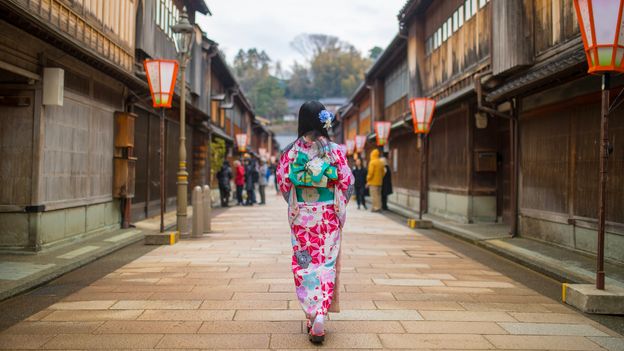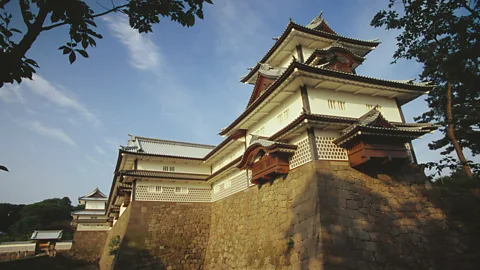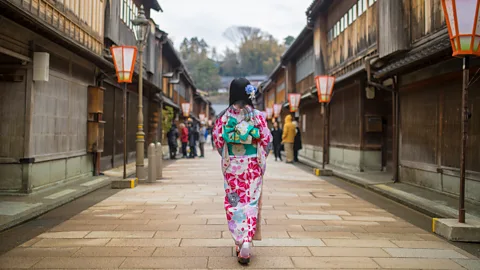Kanazawa, Japan’s samurai city, famously embraced culture and arts over martial conflict. This historic decision fostered a unique legacy of peace and creativity.
Kanazawa stands out as an exceptional example of a city that turned to the nurture of arts, including gold leaf craftsmanship, geisha and tea house culture, rather than the pursuit of war. Situated in Ishikawa Prefecture, this city became a hub for Edo-period artisans and has since cultivated a rich heritage that continues attracting visitors worldwide.
Home to the beautiful Kenrokuen Garden, one of Japan’s “Three Great Gardens,” and districts filled with well-preserved samurai and geisha houses, Kanazawa tells the tale of a society that valued and preserved the beauty of its peaceful and artistic endeavors. Emphasizing traditional crafts, cultural events, and a history steeped in the support of the arts, Kanazawa offers a fascinating glimpse into a city that chose a path of artistry over aggression, setting a precedent that continues to resonate through time.

Credit: www.bbc.com
The Dawn Of Samurai City-Japan’s Samurai City
Welcome to the captivating origin story of Japan’s legendary Samurai City, a place where the brush has mirrored the sword, creating a unique tapestry of culture and history. Let’s embark on a journey to discover how this city embraced art amidst a period renowned for martial prowess and feudal strife.
Feudal Foundations
In the heartland of Japan, the seeds of a future Samurai City took root under the rule of powerful lords. Feudalism laid the groundwork for a society poised on the edge of significant transformation. These Lords built castles, lived by the code of bushido, and protected their realms.
| Lords | Castles | Bushido | Realms |
|---|---|---|---|
| Guardians of regions | Strongholds of power | Samurai code of conduct | Domains to protect |
The Rise Of The Samurai Class
As warriors dedicated to honor and duty emerged, the samurai class began to ascend. From adept archers to master swordsmen, these skilled fighters formed the backbone of armies that fought for control and defended territories.
- Samurai training cultivated formidable fighters.
- Military tactics were honed to precision.
- Loyalty and oaths bound them to their lords.
Art, too, flourished under the samurai. They embraced poetry, calligraphy, and painting, crafting a legacy of enlightenment alongside war. Over time, a city renowned for its samurai heritage grew to become a beacon of cultural brilliance in a country famed for its warriors.

Credit: nashvillenow.us
Legendary Warriors And Their Code
The samurai of Japan were more than just warriors; they were icons of honor and loyalty. Their code, deeply woven into the fabric of Japanese culture, continues to inspire even today. Let’s delve into the world of these legendary figures and discover what truly defined their existence.
Bushido: The Way Of The Warrior-Art Triumphs War
Bushido, or “the way of the warrior,” was the samurai’s beating heart. This code wasn’t written in scrolls but passed down through generations. It became the samurai’s unwritten guide to life and death. Bushido emphasized virtues such as:
- Rectitude: The backbone of samurai decisions.
- Courage: Bravery that knew no bounds.
- Benevolence: Kindness despite their strength.
- Respect: Earned and given freely.
- Honesty: A samurai’s word was his bond.
- Honor: Their reputation preceded them.
- Loyalty: Fierce to their lords and comrades.
- Self-Control: Emotions held in check.
Daily Life Of A Samurai
The daily grind for a samurai was rigorous and disciplined. Their life was a study in contrast – serene yet always ready for combat. A typical day would include:
| Morning | Afternoon | Evening |
|---|---|---|
|
|
|
Yet, beyond the battlefield and rigorous training, samurai had an intimate relationship with arts and culture. They cultivated virtues through tea ceremonies, ink painting, and poetry, forging a unique legacy that blended the ferocity of a warrior with the delicate touch of an artist.
Centuries Of Conflict
The land of the samurai, Japan, tells a story of fierce warriors and clashing swords. Before settling into an era of peace and art, samurai cities faced violent battles and relentless sieges. The era was marked by steel, strategy, and the struggle for power.
Epic Battles And Historic Sieges
Intriguing tales of samurai valor unfold during periods of epic battles and historic sieges. The fortresses of Japan endured assaults by enemies eager for dominance. Their walls, scarred by warfare, witnessed the rise and fall of many samurai heroes.
- Battle of Sekigahara: Unified the nation under Tokugawa Ieyasu.
- Siege of Osaka: Ended the Toyotomi lineage, securing Tokugawa power.
The resilience and tactics of samurai during these times crafted the very history of Japan’s feudal landscape.
The Warring States Period
The Warring States Period, known as Sengoku Jidai, was a time of relentless strife. Daimyos, powerful regional lords, scrambled for land and power, leading to constant conflicts. Here are a few significant aspects:
- Divided territories under the rule of competing daimyos.
- Incessant power struggles shaped the political tapestry of Japan.
- Samurai served their daimyos with unmatched loyalty and martial prowess.
This tumultuous period set the stage for the rise of centralized power and the eventual embrace of culture and arts over warfare.
Economic And Social Structures
Samurai City, known for its treasured history, paints a picture of a society thriving not on the edge of the sword, but on the vibrancy of its economy and social structure. This city, with a tale as intriguing as any artwork it fosters, invites us to explore the intricate weave of trade and societal norms that set it apart from the warring ethos typically associated with Samurai.
Trade And Commerce In Samurai City
Trade empowered Samurai City to flourish. Artisans and merchants, an economic artery, pumped wealth into the city’s heart.
- Silk and tea transcended borders, weaving relationships with distant lands.
- Paper and pottery, with the unique touch of local craftsmen, became coveted treasures beyond city walls.
The bustling marketplaces and the entrepreneurial spirit of its people propelled Samurai City into an era of prosperity.
Hierarchy And The Social Order
Despite its peaceful inclinations, social hierarchy played an instrumental role in the city’s fabric.
- Samurai occupied the esteemed top tier, respected for their leadership and mastery of the arts.
- Peasants, the backbone of agriculture, ensured a steady supply of food and raw materials.
- Artisans and merchants, once viewed less favorably, gained prestige as agents of economic vigor.
This social strata, with each layer supporting the next, formed a resilient structure that thrived on cooperation and respect.
Artistic Blossoming Amidst Strife
The story of Japan’s Samurai City is a tale of unexpected transformation. War cast a long shadow over medieval Japan. Yet, in one remarkable city, brushes replaced swords. Artists flourished where warriors once stood. This city chose an unlikely path, becoming a beacon of art in a time of conflict.
Cultural Innovations
Japan’s Samurai City witnessed a unique fusion of art and culture. A new aesthetic emerged, blending the spirit of samurai with artistic pursuits. Notable advancements include:
- Revolutionary art forms that combined traditional techniques with modern themes.
- Creation of vibrant paintings depicting scenes of bravery and beauty.
- Poetry gatherings where samurais and artists exchanged ideas, fostering a literary boom.
These innovations captured the city’s soul, painting a canvas of resilience and creativity.
Preserving Beauty In Times Of War
Even as battles raged, this city’s commitment to beauty remained unshaken. Key efforts to protect art included:
- Safeguarding artworks in temple vaults and secret locations to shield them from harm.
- Establishing Artisan Guilds that focused on the transmission of skills and traditions.
- Encouraging the younger generation to pursue art through sponsorship programs.
These measures ensured the art survived and continued to inspire amidst upheaval.
The Architecture Of Defense And Aesthetics
Imagine an ancient Japanese city where sharp swords once silenced whispers. Now, picture peaceful art galleries and serene gardens taking their place. This is the true story of a samurai city’s transformation, a tale of beauty rising from the ashes of war. The architecture that once defended now invites contemplation and calm.
Castle Towns: Form And Function
Japan’s historical castle towns blend strength with elegance. Thick walls and moats protected these places. They also had wide streets and strategic layouts. This design let samurai rush to defend quickly.
Important features:
- Stone foundations were built high. They kept enemies out and gave a grand view.
- Wooden constructions: Combining strength and beauty, these buildings served both for living and as fortresses.
- Hidden pathways weaved through the towns. Samurai used them for surprise attacks or quick escapes.
Gardens And Teahouses: Spaces Of Serenity
The city’s gardens and teahouses tell a different story. They are stories of peace, not war. Built for relaxation and reflection, they show Japan’s love for nature and art.
Gardens made with stones, water, and plants, create calm. The teahouses offer a quiet space to enjoy tea. Together, they form escapes within the city.
| Type | Features | Experience |
|---|---|---|
| Gardens |
| A place for calm thoughts and quiet walks. |
| Teahouses |
| Enjoy traditional tea and escape daily life. |
In both designs, there’s a focus on aesthetic appeal and thoughtful use of space. The city turned its back on conflict and welcomed tranquility. Today, visitors can explore this blend of defense structures and peaceful gardens that form the samurai city’s unique legacy.
Transition To Peaceful Times
As the war-torn eras faded, Japan’s samurai city witnessed a remarkable transformation. The story of its metamorphosis from battleground tensions to a haven of art and culture is a tale of resilience and adaptability.
The Unification Of Japan
Amidst political turmoil, the late 16th century heralded a period of unification for Japan. Mighty warlords known as daimyos, who had once clashed fiercely, began to lay down their arms.
The age of Sengoku, characterized by warring states, saw the rise of three unifiers: Oda Nobunaga, Toyotomi Hideyoshi, and Tokugawa Ieyasu. Their vision and determination forged a single, cohesive Japan.
- Oda Nobunaga initiated the unification with strategic alliances and conquests.
- Toyotomi Hideyoshi continued the quest, focusing on stabilization and societal reform.
- Tokugawa Ieyasu, the final unifier, established the Tokugawa Shogunate, ushering in peace.
From Swords To Plowshares: The Changing Samurai
The newfound peace had a profound effect on the samurai. Once warriors, they now sought roles in a society no longer governed by the sword.
Samurais adapted to peacetime with grace. They turned to agriculture, craftsmanship, and administration. A culture of refinement and education bloomed, replacing the chaos of war.
| Warrior Role | Peacetime Transition |
|---|---|
| Battle Strategy | Political Participation |
| Martial Training | Educational Pursuits |
| Armed Conflict | Artistic and Cultural Development |
Art emerged as a powerful form of expression. Former soldiers became patrons and creators of art. Their heritage, shaped by discipline and the way of the warrior, now enriched the arts.
Galleries and schools flourished, showcasing the diversity of Japanese art. Samurai swords gave way to brushes, and the bloodshed of battles transformed into the serenity of landscapes on canvas.

Credit: www.bbc.com
An Enduring Legacy
The story of a Samurai City that chose art over war paints a vivid picture of a unique chapter in Japanese history. This remarkable transition from swords to brushes left an indelible mark that still resonates in modern Japan. Today, the enduring legacy of this peaceful metamorphosis continues to draw both locals and tourists, eager to explore a cultural heritage steeped in honor, aesthetics, and history.
Samurai Influences In Modern Japan
Samurai ethics and aesthetics continue to influence various aspects of modern Japanese culture. You can witness this through:
- Martial arts practices that emphasize discipline and honor.
- Aesthetics in fashion seen in patterns and motifs used in clothing.
- Architecture grounded in minimalism and strength.
- Bushido-inspired business codes promoting loyalty and diligence.
Preservation And Celebration Of Samurai Culture
The city fervently preserves the rich Samurai heritage through multiple endeavors:
- Museums and galleries showcasing Samurai art and artifacts.
- Festivals, such as the Kendo festival, celebrating Samurai skills.
- Restored residences of Samurai warriors open to visitors.
- Art programs encouraging traditional craftsmanship.
These efforts ensure that the values and traditions of the Samurai era are not just a relic of the past but a living, breathing part of Japan’s identity.
Frequently Asked Questions
What Started The Japanese Civil War?
The Japanese Civil War, also known as the Genpei War, began due to a power struggle between the Taira and Minamoto clans in 1180.
What Ended The Samurai Era?
The Meiji Restoration in 1868 signaled the end of the samurai era, as modernization and westernization reforms led to the samurai class’s dissolution.
What Does Daimyo Mean?
A daimyo was a powerful Japanese feudal lord who ruled large areas of the country from the 10th to the 19th century. These lords had considerable military might and were vassals of the shogun.
How Many Samurai Were There In Feudal Japan?
The number of samurai in feudal Japan varied over time, but estimates suggest around 5% of the population were samurai during peak periods.
Conclusion
The Samurai City’s transition from martial might to artistic haven is a testament to the enduring power of cultural evolution. This remarkable pivot showcases human capacity for change, transcending a legacy of conflict. Embracing art over war, this city not only enriched its heritage but also offered a blueprint for peace through creativity.
Witnessing its story, we find inspiration and a reminder that beauty can emerge from even the most turbulent histories.
